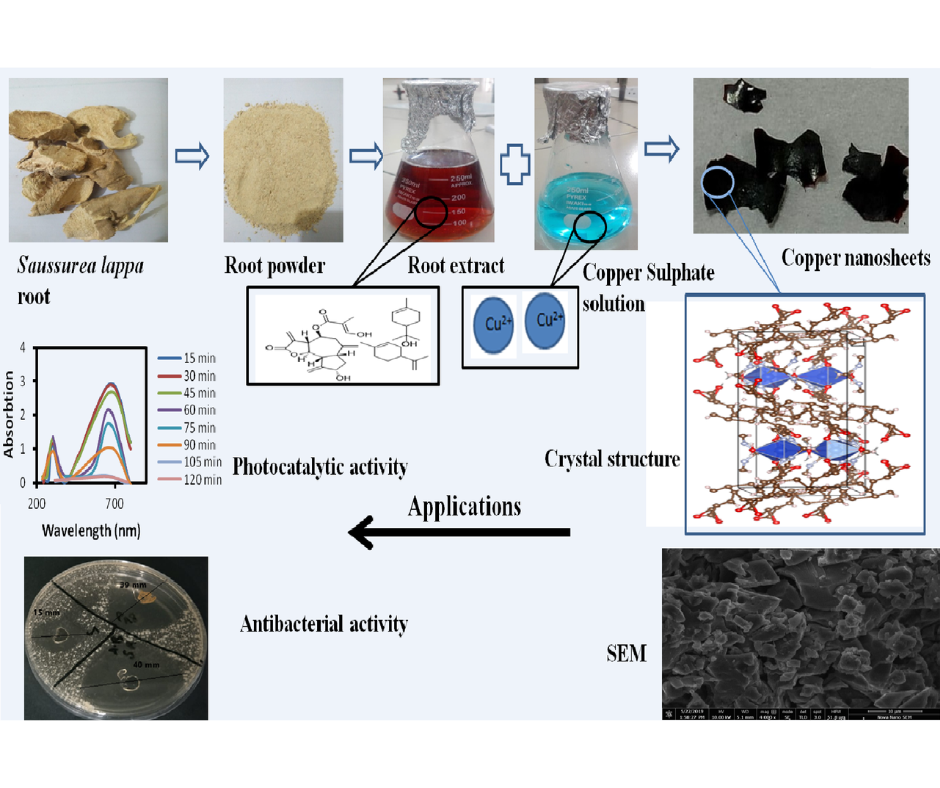
Aqueous phase synthesis of 2-D copper nanosheets stabilized by organic moieties with enhanced photocatalytic and biological activity.
Authors
Asma Sohail , Widya Fatriasari , Sobia Zia , Shahnaz , Shagufta IrshadDOI:
10.29303/aca.v7i2.211Published:
2024-10-31Issue:
Vol. 7 No. 2 (2024)Keywords:
Copper nanosheets, Photocatalytic, Antioxidant activity, Organic moieties, antibacterial, Saussurea lappaArticles
Downloads
How to Cite
Downloads
Metrics
Abstract
Copper nanosheets supported by organic ligands are significant for biological, electrical, and catalytic applications. The discovery that the coronavirus has a significantly reduced maximum survival period on copper surfaces has elevated the utility of copper nanomaterials. Here, we report a non-hazardous and inexpensive biological technique for forming copper nanosheets (Cu Nsts); synthesis of Cu Nsts has always been a challenge for researchers due to the significant problem of oxidation; in this research, we have successfully synthesized stable Cu Nsts by using Saussurea lappa root extract for the first time, the obtained Cu Nsts has a shiny black color with self-standing ability, the crystal structure of Cu nanosheets was determined using Powder X-ray diffraction (PXRD), Scanning electron microscopy (SEM) revealed that copper nanoparticles grow and aggregates to form Cu Nsts. The surface morphology of Cu Nsts is clear evidence of their synthesis. These nanosheets were very proficient in the deduction of harmful dye (methylene blue); within 105 minutes, the degradation capacity of Cu nanosheets for methylene blue reached 93.493%. This remarkable property of Cu Nsts as a photocatalyst gives potential application for removing dyes from industrial wastewater. Cu Nsts showed excellent antioxidant and antibacterial activity. The Cu Nsts demonstrated potent inhibitory zones against E. coli, with inhibition zones measuring 39 mm. This research lays the foundations for purifying wastewater from harmful dyes and bacteria.
References
F. J. Heiligtag and M. J. M. T. Niederberger (2013) The fascinating world of nanoparticle research. materialstoday vol. 16, no. 7-8, pp. 262-271. https://doi.org/10.1016/j.mattod.2013.07.004
S. Rajeshkumar and L. J. C.-b. i. Bharath (2017) Mechanism of plant-mediated synthesis of silver nanoparticles a review on biomolecules involved, characterisation and antibacterial activity. Chemico-Biological Interactions vol. 273, pp. 219-227. https://doi.org/10.1016/j.cbi.2017.06.019
S. Baker, B. Harini, D. Rakshith, and S. J. J. o. P. R. Satish (2013) Marine microbes: invisible nanofactories. Journal of Pharmacy Research vol. 6, no. 3, pp. 383-388. https://doi.org/10.1016/j.jopr.2013.03.001
M. S. Usman, M. E. El Zowalaty, K. Shameli, N. Zainuddin, M. Salama, and N. A. J. I. j. o. n. Ibrahim (2013) Synthesis, characterization, and antimicrobial properties of copper nanoparticles. International Journal of Nanomedicinevol 8, p. 4467. https://doi.org/10.2147/IJN.S50837
M. Liu, P. A. Gurr, Q. Fu, P. A. Webley, and G. G. J. J. o. M. C. A. Qiao (2018) Two-dimensional nanosheet-based gas separation membranes. Materials Chemistry A vol. 6, no. 46, pp. 23169-23196. https://doi.org/10.1039/C8TA09070J
P. Ananthi and S. M. J. J. I. J. I. R. S. E. T. Kala (2017) Plant extract mediated synthesis and characterization of copper nanoparticles and their pharmacological activities. International Journal of Innovative Research in Science, Engineering and Technology, vol. 6, pp. 13455-13465. DOI:10.15680/IJIRSET.2017.0607206
A. Tamilvanan, K. Balamurugan, K. Ponappa, and B. M. J. I. J. o. N. Kumar (2014) Copper nanoparticles: synthetic strategies, properties and multifunctional application. International Journal of Nanoscience vol. 13, no. 02, p. 1430001. https://doi.org/10.1142/S0219581X14300016
K. Madhuri, K. Elango, S. J. O. p. Ponnusankar, and E. medicine (2012) Saussurea lappa (Kuth root): review of its traditional uses, phytochemistry and pharmacology. Oriental pharmacy and experimental medicine vol. 12, no. 1, pp. 1-9. https://doi.org/10.1007/s13596-011-0043-1
R. Suman et al. (2020) Sustainability of coronavirus on different surfaces. Journal of Clinical and Experimental Hepatology vol. 10, no. 4, pp. 386-390. https://doi.org/10.1016/j.jceh.2020.04.020
A. Ali et al. (2021) Saussurea lappa: An Important Medicinal Plant for Treatment Different Diseases: A review. Kufa Journal for Nursing Sciences vol. 11, no. 1, pp. 1-8. https://doi.org/10.36321/kjns.vi20211.427
K. Madhuri, K. Elango, and S. Ponnusankar (2012) Saussurea lappa (Kuth root): review of its traditional uses, phytochemistry and pharmacology. Oriental pharmacy and Experimental medicine. vol. 12, pp. 1-9. https://doi.org/10.1007/s13596-011-0043-1
M. M. Pandey, S. Rastogi, and A. K. S. Rawat (2007) Saussurea costus: Botanical, chemical and pharmacological review of an ayurvedic medicinal plant. Journal of ethnopharmacology vol. 110, no. 3, pp. 379-390. https://doi.org/10.1016/j.jep.2006.12.033
K. Zahara et al. (2014) A review of therapeutic potential of Saussurea lappa-An endangered plant from Himalaya. Asian Pacific journal of tropical medicine vol. 7, pp. S60-S69. https://doi.org/10.1016/S1995-7645(14)60204-2
M. M. Deabes, A.-E. Fatah, I. Sally, S. H. E. Salem, and K. M. Naguib (2021) Antimicrobial activity of bioactive compounds extract from Saussurea costus against food spoilage microorganisms. Egyptian Journal of Chemistry. vol. 64, no. 6, pp. 2833-2843. https://doi.org/10.21608/ejchem.2021.69572.3528
O. Akhavan and E. J. S. Ghaderi (2010) Cu and CuO nanoparticles immobilized by silica thin films as antibacterial materials and photocatalysts. Surface and Coatings Technology vol. 205, no. 1, pp. 219-223. https://doi.org/10.1016/j.surfcoat.2010.06.036
[C. Tang, X. Huang, H. Wang, H. Shi, and G. J. J. o. h. m. Zhao (2020) Mechanism investigation on the enhanced photocatalytic oxidation of nonylphenol on hydrophobic TiO2 nanotubes. Journal of Hazardous Materials vol. 382, p. 121017. https://doi.org/10.1016/j.jhazmat.2019.121017
R. Ahmad and R. Kumar (2010) Adsorption studies of hazardous malachite green onto treated ginger waste. Journal of environmental management vol. 91, no. 4, pp. 1032-1038. https://doi.org/10.1016/j.jenvman.2009.12.016
A. K. Moorthy, B. G. Rathi, S. P. Shukla, K. Kumar, and V. S. Bharti (2021) Acute toxicity of textile dye Methylene blue on growth and metabolism of selected freshwater microalgae. Environmental Toxicology and Pharmacology vol. 82, p. 103552. https://doi.org/10.1016/j.etap.2020.103552
T. Sinha, M. J. E. S. Ahmaruzzaman, and P. Research (2015) Green synthesis of copper nanoparticles for the efficient removal (degradation) of dye from aqueous phase. Environ Sci Pollut Res vol. 22, no. 24, pp. 20092-20100. https://doi.org/10.1007/s11356-015-5223-y
R. A. Soomro, A. Nafady, S. T. H. Sherazi, N. H. Kalwar, M. R. Shah, and K. R. J. J. o. N. Hallam (2015) Catalytic reductive degradation of methyl orange using air resilient copper nanostructures. Journal of Nanomaterials vol. 2015. https://doi.org/10.1155/2015/136164
S. Lee, S. Wang, C. Wern, and S. J. M. Yi (2021) The Green Synthesis of 2D Copper Nanosheets and Their Light Absorption. Materials vol. 14, no. 8, p. 1926. https://doi.org/10.3390/ma14081926
R. Singh, K. Chahal, N. J. J. o. P. Singla, and Phytochemistry (2017) Chemical composition and pharmacological activities of Saussurea lappa: A review. Journal of Pharmacognosy and Phytochemistry vol. 6, pp. 1298-1308.
S. Irshad et al. (2018) Green tea leaves mediated ZnO nanoparticles and its antimicrobial activity. Cogent Chemistry vol. 4, no. 1, p. 1469207. https://doi.org/10.1080/23312009.2018.1469207
S. Ningaraju et al. (2021) Chaetomium globosum extract mediated gold nanoparticle synthesis and potent anti-inflammatory activity. Analytical Biochemistry vol 612, p. 113970. https://doi.org/10.1016/j.ab.2020.113970
B. Kumar, S. Saha, M. Basu, and A. K. J. J. o. M. C. A. Ganguli (2013) Enhanced hydrogen/oxygen evolution and stability of nanocrystalline (4–6 nm) copper particles. Journal of Materials Chemistry A vol. 1, no. 15, pp. 4728-4735. https://doi.org/10.1039/C3TA01194A
S. Muthu and M. B. J. M. T. P. Sridharan (2018) Synthesis and characterization of two dimensional copper selenide (CuSe) Nanosheets. Materials Today Proceedings vol. 5, no. 11, pp. 23161-23168. https://doi.org/10.1016/j.matpr.2018.11.047
R. Khani, B. Roostaei, G. Bagherzade, and M. J. J. o. M. L. Moudi (2018) Green synthesis of copper nanoparticles by fruit extract of Ziziphus spina-christi (L.) Willd.: Application for adsorption of triphenylmethane dye and antibacterial assay. Journal of Molecular Liquids vol. 255, pp. 541-549. https://doi.org/10.1016/j.molliq.2018.02.010
[S. Pratapa et al. (2010)XRD line‐broadening characteristics of M‐oxides (M= Mg, Mg‐Al, Y, Fe) nanoparticles produced by coprecipitation method. AIP Conference Proceedings. vol. 1284, no. 1, pp. 125-128: American Institute of Physics. https://doi.org/10.1063/1.3515533
H. J. A. C. Rietveld (1967) Line profiles of neutron powder-diffraction peaks for structure refinement. Acta Cryst vol. 22, no. 1, pp. 151-152. https://doi.org/10.1107/S0365110X67000234
H. M. J. J. o. a. C. Rietveld (1969) A profile refinement method for nuclear and magnetic structures. J. Appl. Cryst vol. 2, no. 2, pp. 65-71. https://doi.org/10.1107/S0021889869006558
N. Hidayat, A. Hidayat, S. Hidayat, N. Mufti, A. Taufiq, and H. Heriyanto (2020) Assessing Rietveld refinement results on silicon carbide nanoparticles produced by magnesiothermal treatment. Journal of Physics: Conference Series vol. 1595, no. 1, p. 012032: IOP Publishing. doi:10.1088/1742-6596/1595/1/012032
S. Atiq et al. (2017) Synthesis and investigation of structural, morphological, magnetic, dielectric and impedance spectroscopic characteristics of Ni-Zn ferrite nanoparticles. Ceramics International vol. 43, no. 2, pp. 2486-2494. https://doi.org/10.1016/j.ceramint.2016.11.046
H. Sadiq et al. (2021) Green synthesis of ZnO nanoparticles from Syzygium Cumini leaves extract with robust photocatalysis applications. Journal of Molecular Liquids vol. 335, p. 116567. https://doi.org/10.1016/j.molliq.2021.116567
N. Khorshidi, S. Khorrami, M. Olya, and F. J. O. J. C. Mottiee (2016) Photodegradation of basic dyes using nanocomposite (silver zinc oxide-copper oxide) and kinetic studies. Oriental journal of chemistry vol. 32, pp. 1205-1214. http://dx.doi.org/10.13005/ojc/320247
K. Rambabu, G. Bharath, F. Banat, and P. L. J. J. o. h. m. Show (2021) Green synthesis of zinc oxide nanoparticles using Phoenix dactylifera waste as bioreductant for effective dye degradation and antibacterial performance in wastewater treatment. Journal of Hazardous Materials vol. 402, p. 123560. https://doi.org/10.1016/j.jhazmat.2020.123560
T. de Oliveira Guidolin et al. (2021) Photocatalytic pathway on the degradation of methylene blue from aqueous solutions using magnetite nanoparticles. Journal of Cleaner Production vol. 318, p. 128556. https://doi.org/10.1016/j.jclepro.2021.128556
M. A. Messih, M. Ahmed, A. Soltan, and S. S. Anis (2019) Synthesis and characterization of novel Ag/ZnO nanoparticles for photocatalytic degradation of methylene blue under UV and solar irradiation. Journal of Physics and Chemistry of Solids vol. 135, p. 109086. https://doi.org/10.1016/j.jpcs.2019.109086
F. Yu et al. (2021) ZnO/biochar nanocomposites via solvent free ball milling for enhanced adsorption and photocatalytic degradation of methylene blue. Journal of Hazardous Materials vol. 415, p. 125511. https://doi.org/10.1016/j.jhazmat.2021.125511
R. Vinayagam et al. (2023) Green synthesized cobalt oxide nanoparticles with photocatalytic activity towards dye removal. Environmental Research vol. 216, p. 114766. https://doi.org/10.1016/j.envres.2022.114766
J. Kadam, P. Dhawal, S. Barve, and S. Kakodkar (2020) Green synthesis of silver nanoparticles using cauliflower waste and their multifaceted applications in photocatalytic degradation of methylene blue dye and Hg 2+ biosensing. SN Applied Science vol. 2, pp. 1-16. https://doi.org/10.1007/s42452-020-2543-4
A. Kirchon, P. Zhang, J. Li, E. A. Joseph, W. Chen, and H.-C. Zhou (2020) Effect of isomorphic metal substitution on the fenton and photo-fenton degradation of methylene blue using Fe-based metal–organic frameworks. ACS applied materials & interfaces vol. 12, no. 8, pp. 9292-9299. https://doi.org/10.1021/acsami.9b21408
N. X. D. Mai, D. Park, J. Yoon, and J. Hur (2018) Comparative study of hydrogel-based recyclable photocatalysts. Journal of Nanoscience and Nanotechnology vol. 18, no. 2, pp. 1361-1364 https://doi.org/10.1166/jnn.2018.14929.
J. Akhtar, M. Tahir, M. Sagir, and H. S. Bamufleh (2020) Improved photocatalytic performance of Gd and Nd co-doped ZnO nanorods for the degradation of methylene blue. Ceramics International vol. 46, no. 8, pp. 11955-11961. https://doi.org/10.1016/j.ceramint.2020.01.234
J. Ye, C. Chao, and J. Hong (2020) Preparation of a novel nano-TiO2 photocatalytic composite using insoluble wood flour as bio-carrier and dissolved components as accelerant. Journal of Materials Research and Technology vol. 9, no. 5, pp. 11255-11262. https://doi.org/10.1016/j.jmrt.2020.07.099
[T. Gur, I. Meydan, H. Seckin, M. Bekmezci, and F. J. E. R. Sen (2022) Green synthesis, characterization and bioactivity of biogenic zinc oxide nanoparticles. Environmental Research vol. 204, p. 111897. https://doi.org/10.1016/j.envres.2021.111897
License
Copyright (c) 2024 Asma Sohail, Widya Fatriasari, Sobia Zia, Shahnaz , Shagufta Irshad

This work is licensed under a Creative Commons Attribution-NonCommercial-ShareAlike 4.0 International License.
Authors who publish with ACA: Acta Chimica Asiana agree to the following terms:
- Authors retain copyright and grant the journal right of first publication with the work simultaneously licensed under a Creative Commons Attribution-NonCommercial-ShareAlike 4.0 International License. This license allows authors to use all articles, data sets, graphics, and appendices in data mining applications, search engines, web sites, blogs, and other platforms by providing an appropriate reference. The journal allows the author(s) to hold the copyright without restrictions and will retain publishing rights without restrictions.
- Authors are able to enter into separate, additional contractual arrangements for the non-exclusive distribution of the journal's published version of the work (e.g., post it to an institutional repository or publish it in a book), with an acknowledgement of its initial publication in ACA: Acta Chimica Asiana.
- Authors are permitted and encouraged to post their work online (e.g., in institutional repositories or on their website) prior to and during the submission process, as it can lead to productive exchanges, as well as earlier and greater citation of published work (See The Effect of Open Access).





 Indonesian Chemical Society, Chapter Nusa Tenggara. Jalan Majapahit 62 Mataram, University of Mataram, 83125, Indonesia
Indonesian Chemical Society, Chapter Nusa Tenggara. Jalan Majapahit 62 Mataram, University of Mataram, 83125, Indonesia





